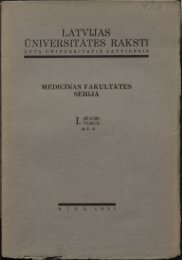UNIVERSITATIS LATVIENSIS - DSpace
UNIVERSITATIS LATVIENSIS - DSpace
UNIVERSITATIS LATVIENSIS - DSpace
Sie wollen auch ein ePaper? Erhöhen Sie die Reichweite Ihrer Titel.
YUMPU macht aus Druck-PDFs automatisch weboptimierte ePaper, die Google liebt.
the tapetum cells are usually not so large as in the other part,<br />
which is turned to the centre of the anther. It is possible<br />
that this inner part of the tapetum<br />
material,<br />
the other part.<br />
cells receives more untritive<br />
because it is situated nearer the vascular bundle than<br />
The tetrad division (Fig. 4) compared with the typical<br />
tetrad division, shows no peculiarities. The division, generally<br />
in the stage of equatorial plate, offers a good opportunity for<br />
counting the chromosomes. There are 7 chromosomes (Fig. 1).<br />
It is also possible to count the chromosomes in the diploid<br />
cells, near the flower (Fig. 18).<br />
The number of the bivalent<br />
chromosomes on the equatorial plate can with certainty be counted<br />
as 14. The diploid chromosomes are larger than the haploid<br />
ones, differing especially in length.<br />
Some of the chromosomes<br />
of the daughter nuclei are left behind, when all are making their<br />
way to the poles of the spindle. Such slowly travelling chro-<br />
mosomes are also noticed in some cases of mitotic division in<br />
the tapetum cells.<br />
During the interkinesis the chromosomes in the nuclei of<br />
dyads are dispersed into grains. The nuclei instead of the<br />
spindle remain united to each other by a bridge of thick plasma<br />
(Fig. 2). In the second phase of the division both figures of<br />
the spindles lie perpendicularly<br />
126<br />
under each other or at a more<br />
or less acute angle, but a parallel position of the spindles is<br />
also sometimes noticed. The chromosomes after division form<br />
the four nuclei of the tetrad, the strings of plasma between<br />
them can be observed for some time. These plasma formations<br />
are observed not only between the daughter nuclei,<br />
but also<br />
between all four nuclei. Afterwards these formations disappear<br />
and the nuclei form the characteristic position of a<br />
every position of the tetrade all four nuclei can<br />
tetrad. In<br />
be seen in the<br />
preparations stained wity gentiana-violett-eosin, the blue nuclei<br />
in that case shine through the red plasma. The pollen during<br />
the formation of nuclei enlarges the quantity of plasma.<br />
The division<br />
of the nucleus into a vegetative one and a generative one has some-<br />
times been observed. Pollen with three nuclei has not been noticed.<br />
The development of the embryo-sac begins with the inten-<br />
sive division of epidermal and subepidermal cells in those places<br />
where the embryo-sacs are to be formed,<br />
and there therefore can<br />
be observed little protuberances (Fig. 8). The cells of the<br />
young embryo-sac in the early stages are very rich in plasma<br />
and in the stained preparations are more deeply<br />
the other cells in the neigbourhood (Fig. 9).<br />
stained then<br />
At the distance<br />
of about<br />
30|i from the top of the protuberance appear<br />
the inte-<br />
guments, first the inner and a little lower the outer,<br />
both in the


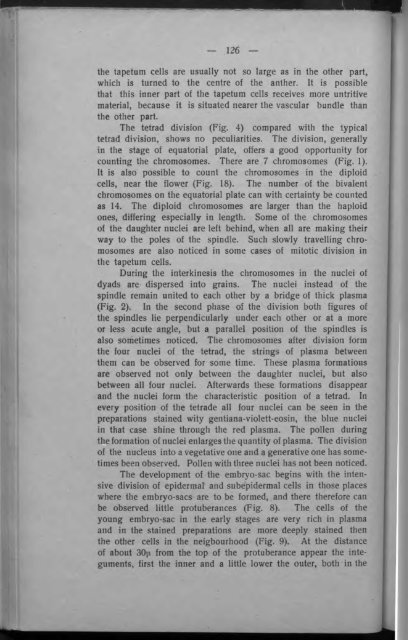
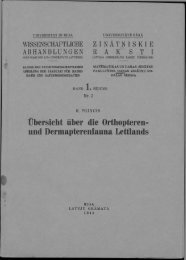
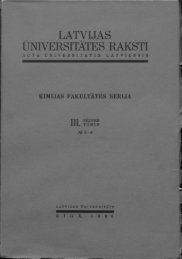
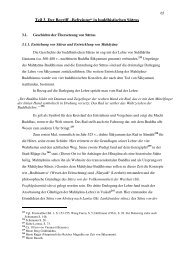


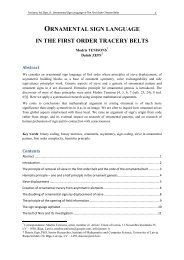
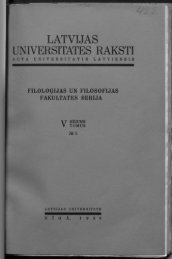
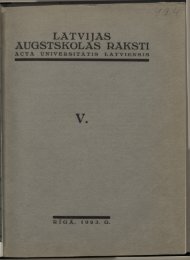


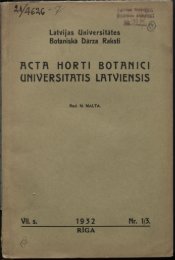
![LATVIJAS] - DSpace](https://img.yumpu.com/11778577/1/190x249/latvijas-dspace.jpg?quality=85)
